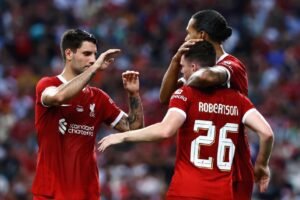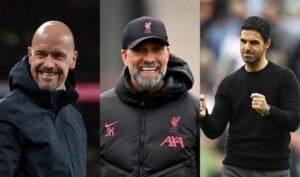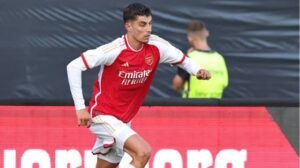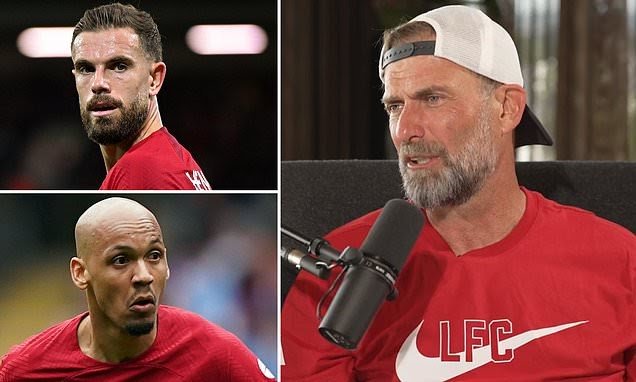Three of Man City’s potential rivals have completely redesigned their midfields in a risky summer move.
The incoming transfer business of Arsenal, Manchester United, and Liverpool shares a common thread: they have invested heavily in better midfielders, younger midfielders, and most intriguingly, more attacking midfielders.
Fabinho, Granit Xhaka, and Jordan Henderson have left the team, and Fred and Scott McTominay might be next. The newcomers are Mason Mount, Dominik Szoboszlai, Alexis Mac Allister, Kai Havertz, Declan Rice, and Kai Havertz.
It increases the likelihood that Manchester City’s potential challengers will set up their midfield threes with two offensive players each, which ironically shows the impact Pep Guardiola and City have had on their rivals.
For Mikel Arteta, Erik ten Hag, and Jurgen Klopp, this daring strategy entails risk, and it also illustrates the evolving function of midfielders in contemporary soccer.
“Five plus five” modifies midfield duties.
Putting David Silva and Kevin De Bruyne in the same midfield three when Guardiola joined City in 2016 was viewed as a radical and possibly reckless move. With two potent central midfielders operating behind them, Silva and De Bruyne were players who were loosely referred to as “No 10s,” operating behind a striker or allowed to drift in from wide. They were raised high into the left and right half-spaces under Guardiola in order to support three forwards and form a front five. The left and right half-spaces are the areas of the field that are halfway between the center and the wing.
Even now, seven years later, it’s rare to watch one of the top Premier League teams without recognizing a variation of this positional structure. Modern football’s flatpack coaching model is some variation of 2-3-5 or 3-2-5, though how these slots are filled can differ. The “back five” aid in establishing play and thwart counterattacks, while the “front five” overwhelm the opposing back four to deal the most damage.

As a result, a number of the players we conveniently refer to as midfielders are actually playing as attackers rather than midfielders. All through the season, this might be the case for Havertz, Mount, Szoboszlai, or MacAllister. The one or two remaining midfielders in the “back five” have a specific, defensive function. The midfielder who performs all tasks, both inside and outside of the penalty boxes, risks having his wings clipped.
Ball progression statistics are one way to show this trend. We picture midfielders as the ones who receive the ball from the defense and link to the attack, but this duty frequently falls to another position. The midfielders are making room in the center of the field instead, and they are relying on their defenders to find them.
Manchester United, Arsenal and Liverpool’s leaders for passes into the final third last season

Shaded players not considered recognised midfielders
Ben White
341
Thomas Partey
ARSENAL
341
Oleksandr Zinchenko
244
Gabriel Magalhaes
244
Aaron Ramsdale
234
Trent Alexander-Arnold
A striking example is Arsenal, where three defenders and goalkeeper Aaron Ramsdale were among the team’s top five passers into the final third of the field last season. The only midfielder to make the top five was Thomas Partey. For one straightforward reason—they were already there—Xhaka and Martin Odegaard weren’t making as many passes into the final third.
Liverpool adopted a more balanced strategy, with Fabinho and Henderson making an appearance, but they heavily relied on Virgil Van Dijk and Trent Alexander-Arnold to open up space for their forwards. The midfielders for Manchester United did appear more frequently during this phase, which may have been due to a deeper starting position or a lack of confidence in their distribution from the back.
The pursuit of greater variety by Arsenal.
Rice’s qualities as a replacement or addition for Partey at Arsenal are obvious, without understating the significance of his signing. The decision by Arteta to replace Xhaka with Havertz is more divisive.
It is understandable that the substitution of a flighty second striker for a tough, combative player who has experience playing in deep midfield has caused some controversy. But the Xhaka who played for Arsenal in 2017 was very different from the one they acquired in 2016. In comparison to previous Premier League campaigns, Xhaka completed fewer passes and had fewer touches per 90 minutes. Run-ups to the penalty area by the Swiss took more time.

Havertz, who last season made more off-the-ball runs into the box than any Premier League player who wasn’t named Erling Haaland, will be encouraged by this. Havertz will probably start in a 4-4-2 with Gabriel Jesus for Arsenal’s defense. Therefore, he will be far from the chaos of the center circle for the majority of the game, even though he must position himself as a pass option.
Arsenal can now invert their right-back, something they were previously limited to doing with Oleksandr Zinchenko from the left last season, thanks to the acquisition of Jurrien Timber. With Arsenal’s center-backs and left-back forming their “back five,” Timber tucking in would push Rice left of center, which is where he prefers to play. Gabriel is a left defender alongside Ben White and William Saliba in the example below. As an alternative, White could withdraw and Jakub Kiwior or Takehiro Tomiyasu would start at left back. As soon as Zinchenko returns, the system might switch from right to left, or Timber might just play from the left.
a total makeover for Liverpool.
Although Liverpool’s engine room has been pleading for renewed vigor for more than a year, the pace of change this summer has still been shocking. Szoboszlai and Mac Allister have replaced Henderson and Fabinho, and Liverpool wants to add one more defensive midfielder to complete the makeover. For Romeo Lavia of Southampton, numerous offers have been made.
Along with this changing of the guard, Klopp made an intriguing adjustment by switching to a 3-2-5 formation a la Guardiola and tucking Alexander-Arnold into midfield. This system maintains five players to defend against the counter-attack, which plagued Liverpool for the majority of the previous season. Ibrihima Konate is able to fill in for Alexander-Arnold when he is on the move.
The previous strategy used by Liverpool has been altered. Alexander-Arnold and Andy Robertson used to overlap their front three and pinch them narrowly to form a front five for Klopp’s team; now, Szoboszlai and Mac Allister will play in between them to form a front five. Of the two, Mac Allister is more likely to drop and assist during the early stages of play. A more technical midfield, it is designed to receive the ball in advanced, congested areas rather than cover for full-backs.

Robertson, who will play like a left-sided center-back to counterbalance Alexander-Arnold inverting from the other side, is one player whose natural instincts must be restrained. Robertson’s forward bursts will have less room if Luiz Diaz or Darwin Nunez hold the left-side width, and his passing skills will be put to the test. It is not a natural fit, which perhaps explains Liverpool’s fruitless interest in Levi Colwill. Additionally, Klopp could use another holding midfield option, which is why he is interested in Lavia.
improved quality of Manchester United.
Although United would still like to add a second midfield player to Mount, their summer transfer activity has been slower than expected, much to the chagrin of their fans. Sofyan Amrabat of Fiorentina has been mentioned as a potential addition to Casemiro’s quality competition at the center of Erik ten Hag’s midfield.
United might start with Mount and Fernandes, two advanced midfielders, pushed forward to form their front five, similar to how Arsenal and Liverpool did. Ten Hag likes Shaw and Wan-Bissaka making incisive runs inside their winger from a narrow position, but United don’t quite have a specialist full-back comfortable in midfield like Timber, Zinchenko, or Alexander-Arnold behind them.
When Jadon Sancho was asked to start up front in preseason, United’s team needed players who were willing to make runs beyond the center-forward, and Mount and Fernandes provided that.
They both press relentlessly, which is essential to maintaining United’s man-to-man defensive strategy.
Although Casemiro, Mount, and Fernandes might not have the ball retention and slower tempo needed to control games, United seems to be leaning toward a high-intensity style of play based on aggression and quick, direct attacks.



